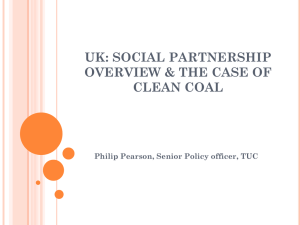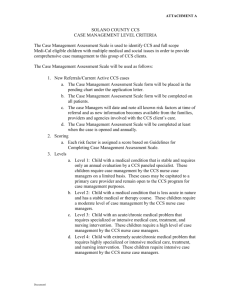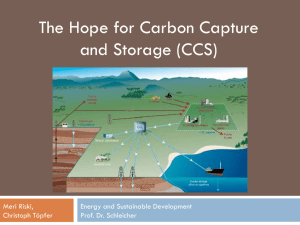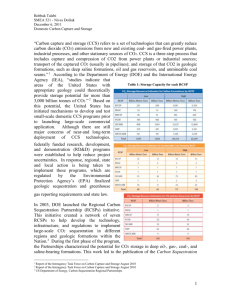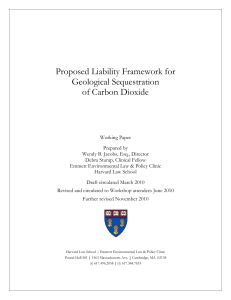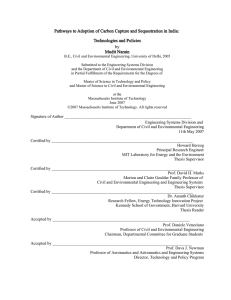Carbon Pipelines Negative – NDI 2012
advertisement
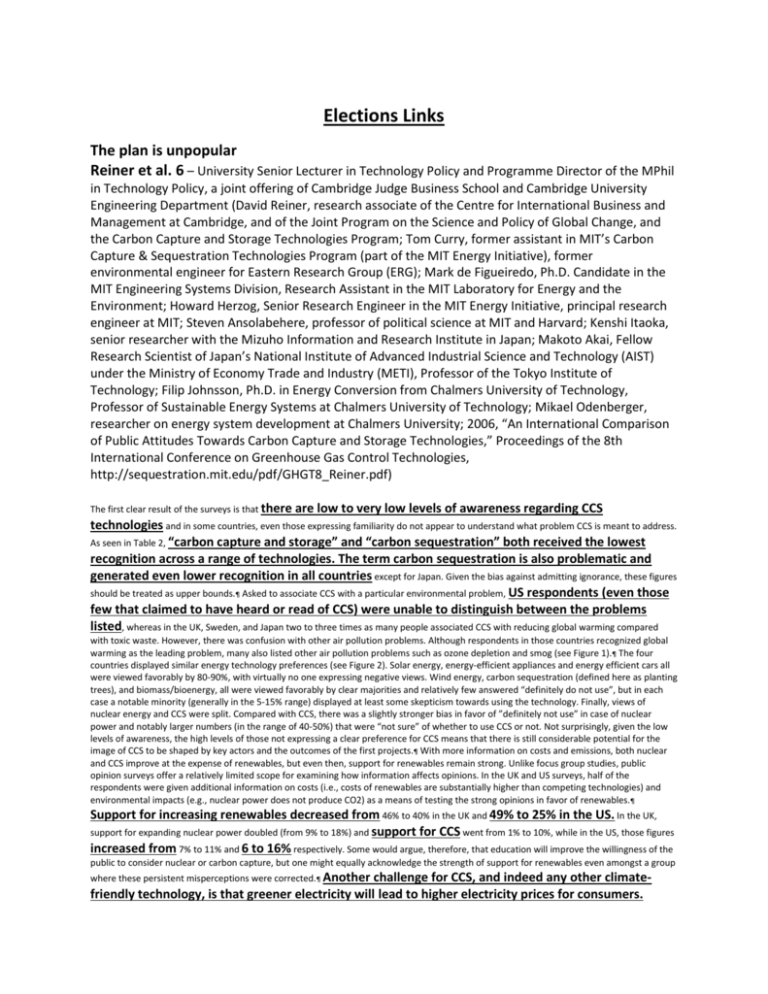
Elections Links The plan is unpopular Reiner et al. 6 – University Senior Lecturer in Technology Policy and Programme Director of the MPhil in Technology Policy, a joint offering of Cambridge Judge Business School and Cambridge University Engineering Department (David Reiner, research associate of the Centre for International Business and Management at Cambridge, and of the Joint Program on the Science and Policy of Global Change, and the Carbon Capture and Storage Technologies Program; Tom Curry, former assistant in MIT’s Carbon Capture & Sequestration Technologies Program (part of the MIT Energy Initiative), former environmental engineer for Eastern Research Group (ERG); Mark de Figueiredo, Ph.D. Candidate in the MIT Engineering Systems Division, Research Assistant in the MIT Laboratory for Energy and the Environment; Howard Herzog, Senior Research Engineer in the MIT Energy Initiative, principal research engineer at MIT; Steven Ansolabehere, professor of political science at MIT and Harvard; Kenshi Itaoka, senior researcher with the Mizuho Information and Research Institute in Japan; Makoto Akai, Fellow Research Scientist of Japan’s National Institute of Advanced Industrial Science and Technology (AIST) under the Ministry of Economy Trade and Industry (METI), Professor of the Tokyo Institute of Technology; Filip Johnsson, Ph.D. in Energy Conversion from Chalmers University of Technology, Professor of Sustainable Energy Systems at Chalmers University of Technology; Mikael Odenberger, researcher on energy system development at Chalmers University; 2006, “An International Comparison of Public Attitudes Towards Carbon Capture and Storage Technologies,” Proceedings of the 8th International Conference on Greenhouse Gas Control Technologies, http://sequestration.mit.edu/pdf/GHGT8_Reiner.pdf) The first clear result of the surveys is that there are low to very low levels of awareness regarding CCS technologies and in some countries, even those expressing familiarity do not appear to understand what problem CCS is meant to address. As seen in Table 2, “carbon capture and storage” and “carbon sequestration” both received the lowest recognition across a range of technologies. The term carbon sequestration is also problematic and generated even lower recognition in all countries except for Japan. Given the bias against admitting ignorance, these figures should be treated as upper bounds.¶ Asked to associate CCS with a particular environmental problem, US respondents (even those few that claimed to have heard or read of CCS) were unable to distinguish between the problems listed, whereas in the UK, Sweden, and Japan two to three times as many people associated CCS with reducing global warming compared with toxic waste. However, there was confusion with other air pollution problems. Although respondents in those countries recognized global warming as the leading problem, many also listed other air pollution problems such as ozone depletion and smog (see Figure 1).¶ The four countries displayed similar energy technology preferences (see Figure 2). Solar energy, energy-efficient appliances and energy efficient cars all were viewed favorably by 80-90%, with virtually no one expressing negative views. Wind energy, carbon sequestration (defined here as planting trees), and biomass/bioenergy, all were viewed favorably by clear majorities and relatively few answered “definitely do not use”, but in each case a notable minority (generally in the 5-15% range) displayed at least some skepticism towards using the technology. Finally, views of nuclear energy and CCS were split. Compared with CCS, there was a slightly stronger bias in favor of ”definitely not use” in case of nuclear power and notably larger numbers (in the range of 40-50%) that were “not sure” of whether to use CCS or not. Not surprisingly, given the low levels of awareness, the high levels of those not expressing a clear preference for CCS means that there is still considerable potential for the image of CCS to be shaped by key actors and the outcomes of the first projects.¶ With more information on costs and emissions, both nuclear and CCS improve at the expense of renewables, but even then, support for renewables remain strong. Unlike focus group studies, public opinion surveys offer a relatively limited scope for examining how information affects opinions. In the UK and US surveys, half of the respondents were given additional information on costs (i.e., costs of renewables are substantially higher than competing technologies) and environmental impacts (e.g., nuclear power does not produce CO2) as a means of testing the strong opinions in favor of renewables.¶ Support for increasing renewables decreased from 46% to 40% in the UK and 49% to 25% in the US. In the UK, support for expanding nuclear power doubled (from 9% to 18%) and support for CCS went from 1% to 10%, while in the US, those figures increased from 7% to 11% and 6 to 16% respectively. Some would argue, therefore, that education will improve the willingness of the public to consider nuclear or carbon capture, but one might equally acknowledge the strength of support for renewables even amongst a group where these persistent misperceptions were corrected.¶ Another challenge for CCS, and indeed any other climatefriendly technology, is that greener electricity will lead to higher electricity prices for consumers. Unfortunately, widespread approval for taking action on climate change or in support of renewables does not mean that the public will support spending more on their electric bill. A recent Eurobarometer study found that over half of European citizens were unwilling to pay anything additional for renewable sources of energy [11]. Asked how much they would pay on top of their existing electric bill to “solve global warming”, 14% of respondents in Japan, 24% in the US, 22% in Britain, and 43% in Sweden refused to pay anything extra (although Swedes do already pay the highest electric bills as a fraction of income). Less than 10% in each survey expressed a willingness to pay more than the equivalent of $50 per month. More generally, there was remarkable similarity in the willingness to pay across countries. Answers may well differ depending on whether willingness to pay is linked to their electric bill or is asked more generally. AT: Modeling The plan doesn’t get modeled – countries prioritize economic growth Schrag, professor of geology, 7 – Sturgis Hooper Professor of Geology at Harvard University (Daniel P., Professor of Environmental Science and Engineering and Director of the Harvard University Center for the Environment, member of President Obama's Council of Advisors on Science and Technology, Ph.D. in geology from UC Berkeley, 2/9/07, “Preparing to Capture Carbon,” Science, Volume 315, Number 5813, pp. 812-813, http://www.uri.edu/hc/2008/2010_Spring/bibliography/Schrag_Science_2007.pdf) If carbon sequestration from coal combustion is essential tomitigate the worst impacts of global warming, what stands in the way of its broad implementation, both in the United States and around the world? With limited coal reserves, countries in the European Union have chosen to emphasize climate mitigation strategies that focus on energy efficiency, renewable sources, and nuclear power. Of the major coal producers, Russia, China, and India have been unwilling to sacrifice short-term economic growth, although Chinese coal gasification efforts, which many see as a step toward sequestration capacity, are more advanced than current U.S. policies. In the United States, there are scientific and economic questions that must be answered before largescale deployment can be achieved. But none of these is critical enough to suggest that carbon sequestration cannot be done. The real obstacle is political will, which may require more dramatic public reaction to climate change impacts before carbon sequestration becomes a requirement for burning coal. In the meantime, there are critical steps that can be taken that will prepare us for the moment when that political will finally arrives.




